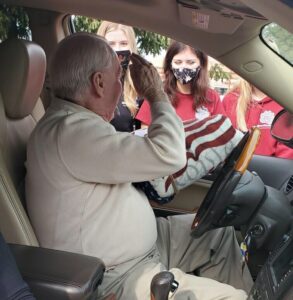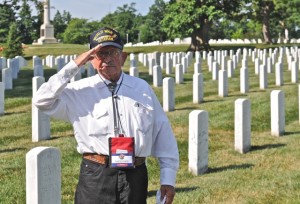2020 Veterans Day Highlights
Use controls above or click here to open this Hometown Heroes podcast in a new window
Episode #654 of Hometown Heroes, airing November 14-16, 2020, highlights some significant developments on and around Veterans Day 2020. In addition to the long awaited opening of the National Museum of the U.S. Army at Fort Belvoir, VA, and the announcement that World War II’s “Rosie the Riveters” will be awarded the Congressional Gold medal, we focus on a heartwarming story from California. 40 students from Granite Hills High School in Porterville, CA presented hand sewn blankets to veterans waiting to visit Washington, D.C. with Central Valley Honor Flight. Watch this piece from Craig Kohlruss of the Fresno Bee to hear what inspired Chloe Ross and the “Heartwarmers Club” that she leads to take on this project.
“My great-grandfather was supposed to go on the flight in April, but he passed away in January,” you’ll hear Chloe say of Pearl Harbor survivor Chuck Keen. “Thankfulness for the freedoms we have because of these veterans is very important to me.”
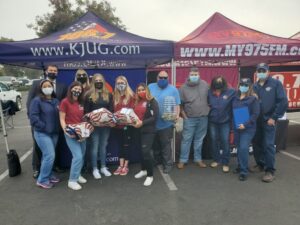
Heartwarmers Club members with Honor Flight volunteers and representatives from Momentum Broadcasting, which helped raised funds to send veterans to their memorials.
Chloe’s great-grandfather shared his World War II story on episode #604 of Hometown Heroes in 2019. If he hadn’t survived December 7th, 1941 aboard the USS Honolulu, not to mention the rest of World War II, Chloe would not be here to catalyze that moving Veterans Day moment for dozens of veterans.
Another special Veterans Day moment came with the debut of the 4-part Netflix series “The Liberator” based on the best-selling book by Alex Kershaw. The first project ever produced employing the “Trioscope” technique that blends live action with animation, the series depicts the amazing World War II story of Felix Sparks and the men he led in the 157th Regiment of the 45th Infantry Division. Watch the official trailer for the series below:
“There’s an awful lot of kids around the world that are really falling in love with American liberators,and the Thunderbirds and World War II,” you’ll hear Alex Kershaw say. “They’re seeing Americans in a really fantastic light, in the best possible light.”
The production technique employed in “The Liberator” not only appeals to younger generations, it also enabled the series to depict large, sweeping scenes that would have been extremely difficult to capture in a purely live action format. Kershaw’s first look at the adaptation came on Veteran’s Day, just as audiences across the globe were getting their first taste of it as well. He is gratified that millions of people around the world are being introduced for the first time to the heroism of “working class Americans” from various backgrounds who liberated occupied Europe. You’ll hear why one character in particular holds powerful meaning for him, and why it’s so satisfying to see a new spotlight shine on the “Thunderbirds” of the 45th Infantry Division.
“Those guys are being rediscovered,” Kershaw observes. “Maybe they’ll be better known around the world than they ever have been.”
As their exploits are introduced to more people, so too will be their diverse backgrounds. Kershaw points out that the 45th Infantry Division boasted approximately 1500 soldiers of Native American descent, more than any other division, in addition to many Mexican-American servicemen.
“It was a victory for all Americans,” Kershaw says of World War II. “All different races and backgrounds.”
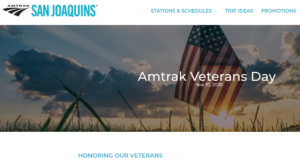
This episode concludes with the sharing of sentiments composed for a special Veterans Day message to patrons of the Amtrak San Joaquins, a network of train routes encompassing California’s Bay Area, Capitol Region, and San Joaquin Valley. Click here to read it on the Amtrak San Joaquins blog, or read below with an interactive version providing links to various veterans’ stories:
Each November, America pauses to recognize the courageous men and women whose service and sacrifice have secured our freedom. No state in our union is home to more veterans than California, and every single day, veterans are moving about the Golden State on the Amtrak San Joaquins. During World War II, some of the same train stops you navigate today were the settings for both tearful goodbyes and joyful reunions. 16 million Americans served in our Armed Forces during WWII, and more than 406,000 of them never had the chance to return home to their families. The National World War II Memorial in Washington, D.C. honors their memory, and the Honor Flight Network sprouted from a desire to take surviving veterans to our nation’s capital to pay tribute to those who made the ultimate sacrifice. Between Honor Flight Kern County, Central Valley Honor Flight, and Honor Flight Bay Area, any World War II, Korean War, or Vietnam War veteran in the territory serviced by Amtrak San Joaquins has an all-volunteer organization ready to provide, free of charge, that inimitable experience that is equal parts gratitude, camaraderie, and catharsis.
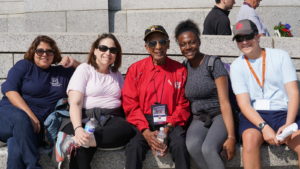
WWII veteran Dr. Fitzalbert Marius at the National World War II Memorial with Central Valley Honor Flight.
Beyond volunteering or contributing to Honor Flight or other veteran-centric charities, there’s a simple step each one of us can take to make every day feel like Veterans Day for those who have served. It’s not a matter of if, but when you will encounter someone with a cap signifying veteran’s status. Consider that your invitation. After you thank that veteran for his or her service, gently and respectfully present a few simple questions. When did you serve? Which branch? Where did Uncle Sam send you? The conversation may last 30 seconds or less, or perhaps it will branch out into 30 minutes or more. Regardless of where your interaction lands on that spectrum, your willingness to listen will mean more to the veteran than you might ever understand.
A glance at the map of stations for the Amtrak San Joaquins brings to mind some of the amazing Americans you might encounter. Beautifully diverse along ethnic, religious, political, and socioeconomic lines, they were united then and remain united now by their ironclad devotion to our nation. At the Martinez stop in the East Bay, it could be Harold Bray, who joined the Navy at age 17 and survived four days in the water after the sinking of the USS Indianapolis. In Sacramento, it might be John Chavez, who still has shrapnel in his head from his WWII Army days, but went on to serve in the Air Force in the Korean War and Vietnam War. In Modesto, asking Francis O’Brien about his missing finger might yield some fascinating tales from his Marine Corps years. Keep chugging down the tracks to Merced County, and you may have the privilege of getting to know Sherman Kishi or Frank Paredes.
One of 33,000 Americans of Japanese ancestry to serve in World War II, Kishi volunteered from an internment camp where his family was being detained behind barbed wire. Paredes, one of America’s few remaining Pearl Harbor survivors, was one of 16 children in his Native American family.
Sit next to the resilient David McCoy in Hanford, and you’d never guess he endured the horrors of Omaha Beach on D-Day. In between the Wasco and Bakersfield stations in Kern County resides Mert Wiedmann, a pharmacist who will fill your prescription for a thrill ride with his mission to fly into a typhoon.
Stepping off in Fresno? Ask lifelong nurse Jane Boote to explain why she once reprimanded legendary General Jimmy Doolittle, or visit one of the last surviving Chinese-American veterans of WWII, Ray Lee, and find out why a room at a local museum is named in his honor. If only my friend Dr. Fitzalbert Marius, a pioneering African-American heart surgeon, were still here to illuminate the comical misunderstanding that led to the then-segregated Army classifying him as Caucasian.
No, these veterans – and their amazing, eye-opening, and inspiring stories – will not be here forever. Regardless of when, where, and how they served, they devoted some of the best years of their lives to a calling greater than themselves. In some manner, visible or invisible, seemingly large or seemingly small, they contributed to the price of our freedom as Americans. On Veterans Day and every day, may we not neglect to express our gratitude, but let’s go a step or two further. Let’s ask a few questions and genuinely listen with an ear for understanding. Armed with the perspective that will inevitably bring, let’s live in such a way that would assign a value to our freedom that measures up to the price they’ve paid.
Paul Loeffler
Host of Hometown Heroes Radio
Co-Founder, Central Valley Honor Flight



